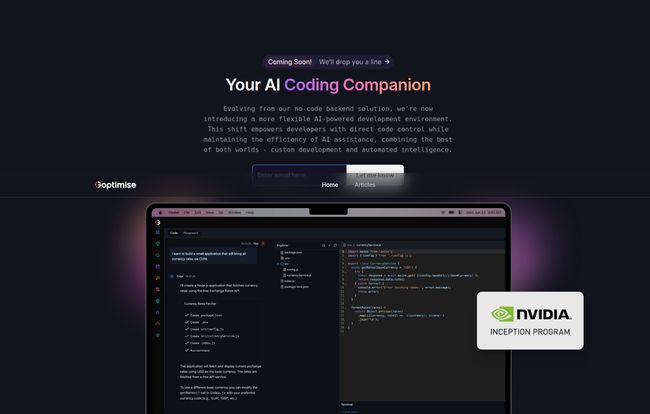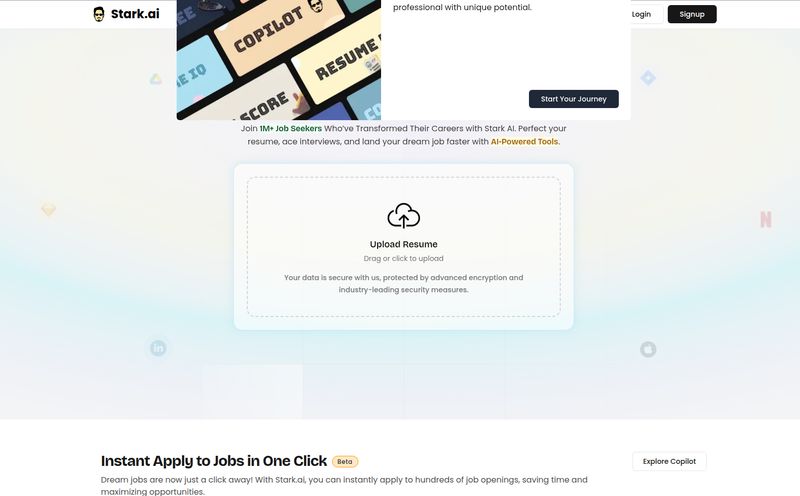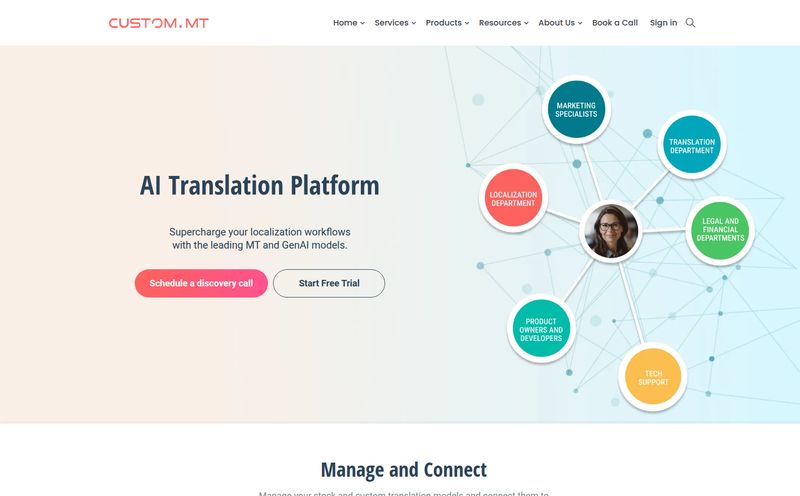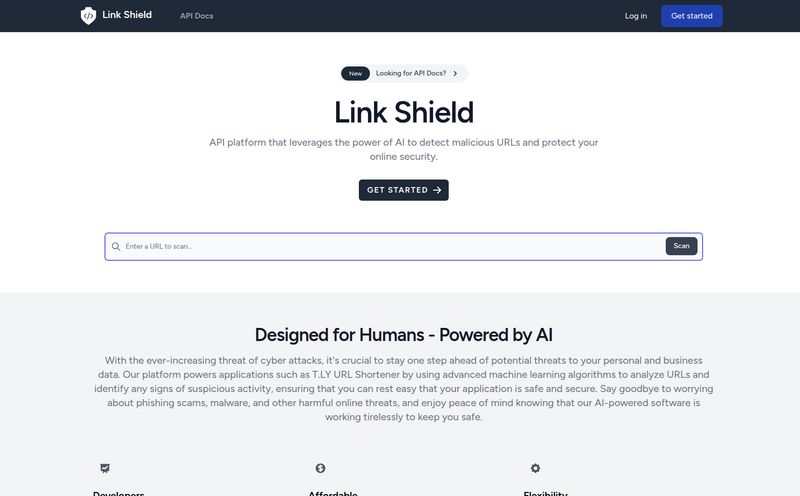We've all been there. Staring at the backend of a new project, feeling that familiar sense of dread. It's the bottleneck. The necessary evil that stands between your brilliant idea and a functioning app. For years, we've been sold a binary choice: the wild west of no-code platforms that promise speed but often crumble under pressure, or the long, arduous path of writing every line of backend code from scratch.
I've lost count of the number of tools that claimed to be the 'one true solution'. So, when I first heard about Goptimise, I was skeptical. Another 'AI-powered, no-code' buzzword salad? But then I saw something that made me lean in a little closer: they're part of the NVIDIA Inception Program. Okay, that's not just marketing fluff. That's a serious stamp of approval.
So I decided to really look into it. Is Goptimise just another tool, or is it a genuine glimpse into the future of how we build things? Let's get into it.

Visit Goptimise
So, What is Goptimise, Really?
At its heart, Goptimise started as a no-code backend builder. But it feels like it's outgrown that label. Calling it 'no-code' is like calling a modern smartphone just a 'telephone'. The platform has evolved into what they call an "AI backend Coding Companion." And honestly, that feels much more accurate.
Think of it less as a drag-and-drop interface and more as a development partner. It's designed to let you build scalable APIs with a visual builder, sure, but the real magic is how it weaves AI into the entire process. It’s a hybrid approach that tries to give you the best of both worlds: the blistering speed of AI-driven automation and the granular control of actual code. It’s an interesting promise, one that many have tried and failed to deliver on.
The Core Features That Actually Matter
A feature list is just a list. What I care about is how those features translate into getting work done faster and better. Here's what stood out to me.
The "NextGen Code" AI Engine
This is the main event. Goptimise isn’t just using AI to autocomplete a line of code here and there. It's built around a more conversational model. You use the Smart Code AI Prompt to describe what you need—an API endpoint, a database query, a specific logic function—and the AI generates the code. I've seen this before, of course, but the integration level here feels a bit deeper. It's not a separate window or a plugin; it's the core workflow.
It's like having a senior delevoper you can bounce ideas off of, 24/7, without the awkward small talk. The goal here isn't to replace the developer but to augment them. To take away the tedious, boilerplate stuff so you can focus on the hard problems. The architecture. The user experience.
DevOps on Autopilot? Pretty Much.
If there's one thing that makes my eye twitch, it's managing infrastructure. Source control, deployment pipelines, server monitoring… it’s a massive time sink. This is an area where Goptimise really shines for me. The built-in Source Control and GitHub integration is seamless. You're not wrestling with weird proprietary versioning systems.
Then there’s the automated code deployment and real-time system status monitoring. You push your code, and Goptimise handles the rest. You can see the health of your system at a glance, without setting up a separate Grafana dashboard or PagerDuty alerts. For a small team or a solo founder, this isn't just a convenience; it's a game-changer. It frees up an incredible amount of mental energy.
Intelligent Bits and Pieces
A couple of smaller features also caught my attention. The platform has an 'Organize Folders' function, which sounds trivial but speaks to their philosophy. It uses AI to suggest a logical file structure. Anyone who's inherited a messy codebase knows how valuable a clean, predictable structure is. The debugging tools are also integrated directly, aiming to make bug-squashing less of a treasure hunt and more of a straightforward process. Little things, but they add up.
Who is This Tool Actually For?
I don't believe in one-size-fits-all tools. Goptimise seems to have a few specific people in mind:
- The Scrappy Startup: You need to build, test, and iterate on an MVP at lightning speed. You don't have the time or the budget for a dedicated backend or DevOps engineer. Goptimise could be your entire backend team in the early days.
- The Freelancer Juggling Projects: When you're billing by the project, efficiency is money. Spinning up a robust, scalable backend in a fraction of the time means you can take on more clients without burning out.
- The Forward-Thinking Agency: Building backends for clients can be repetitive. A tool like this standardizes the process, reduces errors, and lets you deliver faster, which always makes clients happy.
Now, who is it not for? If you're a systems programmer who wants to fine-tune memory allocation or write custom kernel modules, this is probably not your cup of tea. There's an inherent trade-off. By abstracting away the deep infrastructure, you do cede some of that ultra-granular control. But for 95% of web applications, that's a trade-off worth making.
Let’s Talk Money: The Goptimise Pricing Tiers
Okay, the all-important question. What’s this going to cost? The pricing page lays out a pretty clear path from testing the waters to full-scale production. It's refreshing to see a clear, tier-based model instead of a vague 'Contact Us for Pricing' button on every plan.
| Plan | Best For | Key Features |
|---|---|---|
| Trial | Testing & Personal Projects | 1 Instance, Shared DB, Community Support |
| Team | Small Teams & Startups | 2 Instances, Dedicated DB, Priority Support, 10 Seats |
| Pro | Growing Businesses | 10 Instances, Usage-based CPU/Memory, Dedicated Support |
| Enterprise | Large-Scale Applications | Custom Everything, Auto-Scaling, Uptime SLA |
In my opinion, the 'Team' plan looks like the sweet spot. It gets you onto dedicated infrastructure and gives you priority support, which is crucial once you have real users. The jump to 'Pro' seems geared towards applications that are starting to see serious, spiky traffic. It's a logical progression.
Conclusion: Is Goptimise the Future?
Look, the hype around AI in development is deafening right now. It's easy to dismiss another tool entering the fray. But Goptimise feels different. It's not just a feature; it's the foundation. They're not trying to take the developer out of the equation. They're trying to build them a better toolbox, a smarter partner.
The combination of a solid no-code foundation, genuinely useful AI assistance, and automated DevOps is a potent one. While there will always be a learning curve with any new platform, and a healthy dose of caution is needed when relying on AI, the potential for increased productivity here is massive. It represents a shift from writing code to directing code.
At the end of the day, Goptimise is a bold bet on what development will look like in the next five years. And based on what I've seen, it’s a bet I'm excited to watch play out.
Frequently Asked Questions
- 1. What exactly is Goptimise?
- Goptimise is an AI-powered backend development platform. It combines a visual no-code builder with an AI coding assistant to help you create and deploy scalable APIs quickly, with less manual work.
- 2. Is Goptimise a pure no-code platform?
- Not anymore. It evolved from a no-code solution into a more flexible environment. While it has visual building tools, its core strength is the AI-assisted coding that gives developers direct control over the code, blending automation with custom development.
- 3. How does the Goptimise AI actually work?
- It uses a feature called Smart Code AI Prompt. You describe the functionality you need in natural language, and its NextGen Code engine generates the necessary code and logic. It's designed to handle everything from API endpoints to complex business logic.
- 4. Is there a free plan for Goptimise?
- Yes, there is a 'Trial' plan. It's designed for you to explore the platform's features for personal projects or testing. It has some limitations, like shared database resources and community-based support, but it's a great way to start.
- 5. Who is the ideal user for Goptimise?
- It’s best for developers, startups, and agencies who need to build and deploy backends efficiently. If you want to accelerate development without getting bogged down in repetitive coding and server management, it's a strong candidate.
- 6. What kind of support does Goptimise offer?
- Support varies by plan. The Trial plan has community support. The Team plan gets you Priority support via a private channel, and the Pro and Enterprise plans offer dedicated support, with Enterprise plans including an uptime SLA.



